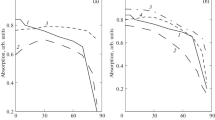Abstract
Recent research on optoelectronic devices focuses on nano structuring which is expected to improve the performance and reduce the production costs of light emitting diodes for lighting purposes and solar cells, for instance. Structuring on the sub-micrometer scale increases the surface with respect to the active volume so that surface effects become crucial for the device performance. In this work we demonstrate the computational modelling of nano structured optoelectronic devices to complement the experiment. The implementation of the simulation model considers surface effects in these devices using a true area box method discretization. The derived surface models are applied on the self-consistent simulation of nano wire quantum disk light emitting diodes. By the computational study we demonstrate that the surface physical effects are critical for the performance of nano-structured optoelectronic devices and that surface recombination can lead to a low efficiency.











Similar content being viewed by others
References
Andreev, Z., Römer, F., Witzigmann, B.: Simulation of InGaN quantum well LEDs with reduced internal polarization. Phys. Status Solidi A 209(3), 487–490 (2012)
Bank, R., Rose, D., Fichtner, W.: Numerical methods for semiconductor device simulation. IEEE Trans. Electron Devices 30(9), 1031–1041 (1983)
Bank, R.E., Bürgler, J.F., Fichtner, W., Smith, R.K.: Some upwinding techniques for finite element approximations of convection-diffusion equations. Numer. Math. 58(1), 185–202 (1990)
Baraff, G.: Semiclassical description of electron transport in semiconductor quantum-well devices. Phys. Rev. B 55(16), 10,745 (1997)
Baur, J., Baumann, F., Peter, M., Engl, K., Zehnder, U., Off, J., Kuemmler, V., Kirsch, M., Strauss, J., Wirth, R., Streubel, K., Hahn, B.: Status of high efficiency and high power ThinGaN®-LED development. Phys. Status Solidi C 6(S2), S905–S908 (2009)
Böcklin, C., Veprek, R.G., Steiger, S., Witzigmann, B.: Computational study of an InGaN/GaN nanocolumn light-emitting diode. Phys. Rev. B 81, 155,306 (2010)
Borgström, M.T., Wallentin, J., Heurlin, M., Stefan, F., Wickert, P., Leene, J., Magnusson, M.H., Deppert, K., Samuelson, L.: Nanowires with promise for photovoltaics. IEEE J. Sel. Top. Quantum Electron. 17(4), 1050–1061 (2011)
Bürgler, J., Bank, R., Fichtner, W., Smith, R.: A new discretization scheme for the semiconductor current continuity equations. IEEE Trans. Comput.-Aided Des. Integr. Circuits Syst. 8(5), 479–489 (1989)
Chuang, S., Chang, C.: K⋅P method for strained wurtzite semiconductors. Phys. Rev. B 54(4), 2491–2504 (1996)
Darling, R.: Defect-state occupation, Fermi-level pinning, and illumination effects on free semiconductor surfaces. Phys. Rev. B 43(5), 4071–4083 (1991)
Deppner, M., Bjelica, M., Römer, F., Witzigmann, B.: Computational study of multi-color InGaN/GaN nanowire LEDs with continuously varied indium composition. In: Proceedings of SPIE, pp. 82,550G–82,550G-11 (2012)
Forniés, E., Zaldo, C., Albella, J.: Control of random texture of monocrystalline silicon cells by angle-resolved optical reflectance. Sol. Energy Mater. Sol. Cells 87(1–4), 583–593 (2005)
Garretón, G.: A hybrid approach to 2D and 3D mesh generation for semiconductor device simulation. Ph.D. Thesis, ETH Zürich (1999)
Gunawan, O., Wang, K., Fallahazad, B., Zhang, Y., Tutuc, E., Guha, S.: High performance wire-array silicon solar cells (August 2010), 307–312 (2011)
Guo, W., Banerjee, A., Bhattacharya, P., Ooi, B.S.: InGaN/GaN disk-in-nanowire white light emitting diodes on (001) silicon. Appl. Phys. Lett. 98(19), 193,102 (2011)
Hjelle, O., Dæhlen, M.: Triangulations and Applications. Springer, Berlin (2006)
Kerkhoven, T.: On the Scharfetter-Gummel box method. Simul. Semicond. Devices Process. 5, 237–240 (1993)
Kočan, M., Rizzi, A., Lüth, H., Keller, S., Mishra, U.: Surface potential at as-grown GaN(0001) MBE layers. Phys. Status Solidi B 234(3), 773–777 (2002)
Luttinger, J., Kohn, W.: Motion of electrons and holes in perturbed periodic fields. Phys. Rev. 173(1950), 869 (1955)
Park, S.H., Chuang, S.L.: Crystal-orientation effects on the piezoelectric field and electronic properties of strained wurtzite semiconductors. Phys. Rev. B 59(7), 4725–4737 (1999)
Rafferty, C., Pinto, M., Dutton, R.: Iterative methods in semiconductor device simulation. IEEE Trans. Electron Devices 32(10), 2018–2027 (1985)
Reshchikov, M.A., Sabuktagin, S., Johnstone, D.K., Morkoç, H.: Transient photovoltage in GaN as measured by atomic force microscope tip. J. Appl. Phys. 96(5), 2556 (2004)
Sanford, N.A., Blanchard, P.T., Bertness, K.A., Mansfield, L., Schlager, J.B., Sanders, A.W., Roshko, A., Burton, B.B., George, S.M.: Steady-state and transient photoconductivity in c-axis GaN nanowires grown by nitrogen-plasma-assisted molecular beam epitaxy. J. Appl. Phys. 107(3), 034,318 (2010)
Scharfetter, D., Gummel, H.: Large-signal analysis of a silicon read diode oscillator. IEEE Trans. Electron Devices 16(1), 64–77 (1969)
Steiger, S., Veprek, R.G., Witzigmann, B.: Unified simulation of transport and luminescence in optoelectronic nanostructures. J. Comput. Electron. 7(4), 509–520 (2008)
Trellakis, A., Galick, A., Pacelli, A., Ravaioli, U.: Iteration scheme for the solution of the two-dimensional Schrödinger-Poisson equations in quantum structures. J. Appl. Phys. 81(12), 7880 (1997)
Veprek, R.G., Steiger, S., Witzigmann, B.: Reliable k⋅p band structure calculation for nanostructures using finite elements. J. Comput. Electron. 7(4), 521–529 (2008)
Waag, A., Wang, X., Fündling, S., Ledig, J., Erenburg, M., Neumann, R., Al Suleiman, M., Merzsch, S., Wei, J., Li, S., Wehmann, H.H., Bergbauer, W., Straßburg, M., Trampert, A., Jahn, U., Riechert, H.: The nanorod approach: GaN NanoLEDs for solid state lighting. Phys. Status Solidi C 8(7–8), 2296–2301 (2011)
Yu, S., Römer, F., Witzigmann, B.: Analysis of surface recombination in nanowire array solar cells. J. Photon. Energy 2(1), 028002 (2012)
Acknowledgements
This work is part of the European Commission Seventh Framework Programme project SMASH. Funding under the contract CP-IP 228999-2 is gratefully acknowledged.
Author information
Authors and Affiliations
Corresponding author
Rights and permissions
About this article
Cite this article
Römer, F., Witzigmann, B. Modelling surface effects in nano wire optoelectronic devices. J Comput Electron 11, 431–439 (2012). https://doi.org/10.1007/s10825-012-0424-9
Published:
Issue Date:
DOI: https://doi.org/10.1007/s10825-012-0424-9




